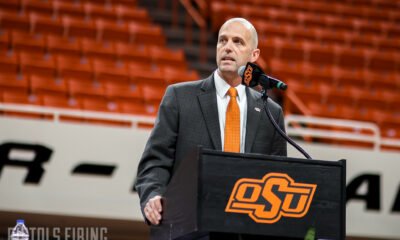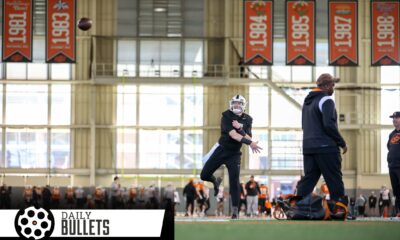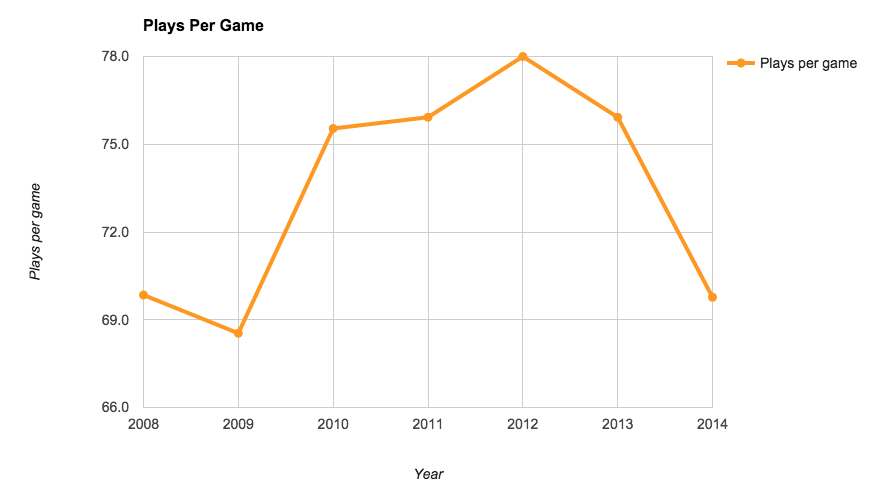Feature
How Many Plays Does OSU Want to Run This Season?

Oklahoma State has always played fast. Maybe not Oregon fast or, more recently, Baylor fast, but it’s been a staple of the Mike Gundy Era.[1. Since he hired Dana.]
How fast does it want to play? Well faster than last year, certainly. I’ve looked at this the last two years and tried to determine a good benchmark for speed of play. The best I can come up with is time of possession divided by total plays.[1. It’s not perfect. The reason these numbers might seem inflated is because a team holds the ball for a while when it punts, has turnovers, and commits penalties. I didn’t include these as offensive “plays” because, well, those are all things that slow an offense down and I don’t feel like they should be added to artificially enhance these numbers.] Here are those numbers.
Seconds per play
2005: 24 seconds per play
2006: 26 seconds per play
2007: 23 seconds per play
2008: 26 seconds per play
2009: 28 seconds per play
2010: 22 seconds per play
2011: 20 seconds per play
2012: 21 seconds per play
2013: 21 seconds per play
2014: 24 seconds per play
A good reference is Baylor which ran a play every 19.9 seconds last season. Lightning.
Last year was the slowest year on a per-play basis for OSU since Dana transformed the offense in 2010. The empirical data backed this up. Also, OSU ran a lot (56 percent of the time in 2014 compared to 51 percent in 2013) which ate up a lot of clock and didn’t move their possessions along quickly.
Like I said, this is not the greatest stat ever, but it’s something.[1. That OSU was so much faster in 2011 than any other year and slower in 2009 than any other year tells me it’s something.] There are a number of things that play into going faster. Chief among them are how quickly you can call and run plays (experience), how quickly you score (talent) and how quickly your defense can get it back to you (as an offense, that’s out of your hands).
I don’t think any of us would call the Pokes “good” at any of these last season. And it’s not like it was slowing down on purpose or running fewer plays so it could score more. No, OSU was slow last year because they were not very good.
“We’d like to play the entire game fast,” said Mike Gundy on media day Saturday in Stillwater. “We should be able to play faster now that we’re more experienced. The quarterback has a better feel for it. Our offensive line played as big of a role in that as anybody last year.
“If you go fast and they’re confused about what they’re doing, then it doesn’t look very good. So we should be able to play faster. Our goal is to get 80 plays in a game. If things go well, we’re firing on all cylinders and our scheme is good, then we’ll hit 90.”
Last year was nowhere close to 90. Or 80.
This will be something to keep an eye on when the season starts. The magic number since Dana came in 2010 has been an average of 75 a game. OSU has had some really good offenses that scored a lot and scored quickly. They’ve all run over 75 plays a game (until last year).
The other factor is how you finish those plays when you start them. QB1 helps.
“He’s 228 (pounds) now so he’s obviously stronger and a little more experienced,” said Gundy. “What I hope for is that he continues that because that’s not something you can coach. Guys can either escape and get away or make a play or they can’t so hopefully he can continue that.”
#okstate Gundy on Rudolph's knack for extending plays: "Those things make the difference in an eight-win season and an 11-win season."
— Bill Haisten ?? (@billhaisten) August 10, 2015

-

 Football3 days ago
Football3 days agoFour-Star Quarterback Adam Schobel Commits to Oklahoma State, Flips from Baylor
-

 Hoops3 days ago
Hoops3 days ago‘Keep Turning Over the Rocks’: Looking at the Portal Landscape as Lutz Looks to Solidify His First OSU Roster
-

 Hoops3 days ago
Hoops3 days agoFour-Star Signee Jeremiah Johnson Reaffirms Commitment to Oklahoma State after Coaching Change
-

 Daily Bullets2 days ago
Daily Bullets2 days agoDaily Bullets (Apr. 23): Pokes Land Four-Star Quarterback, Retain Talent from Mike Boynton Era







